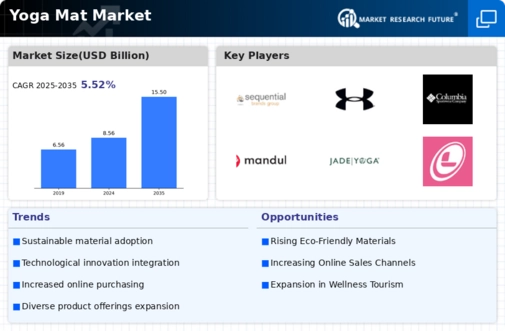Market Share
Yoga Mat Market Share Analysis
The yoga mat market has seen substantial growth and evolution, reflecting the increasing popularity of yoga and mindfulness practices worldwide. Yoga mats, essential for providing comfort and stability during yoga sessions, have become a staple for practitioners of all levels, from beginners to advanced yogis. One notable trend in the yoga mat market is the demand for eco-friendly and sustainable materials. As environmental awareness grows, consumers are increasingly seeking yoga mats made from natural, biodegradable, and non-toxic materials such as natural rubber, cork, and organic cotton. This trend towards sustainability aligns with the values of many yoga enthusiasts who prioritize health, wellness, and environmental consciousness.
Moreover, the market has witnessed a shift towards innovative designs and features to enhance the yoga experience. Manufacturers are incorporating advanced materials and technologies to create yoga mats with improved grip, cushioning, and durability. Anti-slip surfaces, alignment guides, and moisture-wicking properties are among the features that have become increasingly common in yoga mats, providing users with added support and stability during their practice. Additionally, some yoga mats are now available in extra-large sizes, catering to taller individuals or those who prefer more space to move freely during their practice.
Another significant trend in the yoga mat market is the customization and personalization of yoga mats. With the rise of digital printing and customization technologies, consumers now have the option to personalize their yoga mats with custom designs, patterns, and artwork. This trend reflects the desire for self-expression and individuality among yoga practitioners who want to personalize their yoga practice and make a statement with their gear. Customized yoga mats also make thoughtful gifts for yoga enthusiasts, offering a unique and personal touch to their practice.
Furthermore, the COVID-19 pandemic has influenced market trends in the yoga mat industry, as more people turn to yoga and home fitness activities for stress relief, relaxation, and physical exercise while staying indoors. With the closure of yoga studios and fitness centers, many consumers have invested in yoga mats to create their own home practice spaces, leading to increased demand for high-quality yoga mats that offer comfort, support, and durability. This surge in demand has prompted manufacturers to innovate and expand their product offerings to meet the needs of the growing home yoga market.
In addition, the rise of online yoga classes and virtual yoga communities has contributed to market trends in the yoga mat industry. With the convenience of streaming platforms and digital technology, consumers can access a wide range of yoga classes and tutorials from the comfort of their homes, eliminating the need for physical attendance at yoga studios. This shift towards online yoga has created new opportunities for yoga mat brands to reach consumers through digital marketing channels and e-commerce platforms, allowing them to showcase their products and engage with customers in virtual spaces.
In conclusion, the yoga mat market continues to grow and evolve as more people embrace yoga and mindfulness practices as part of their wellness routines. From eco-friendly materials and innovative designs to customization options and virtual yoga experiences, yoga mat brands are adapting to meet the evolving needs and preferences of today's consumers. As the popularity of yoga continues to rise, driven by lifestyle changes and the ongoing impact of the COVID-19 pandemic, the yoga mat market is expected to remain strong and vibrant, offering new opportunities for growth and innovation in the years to come.









Leave a Comment